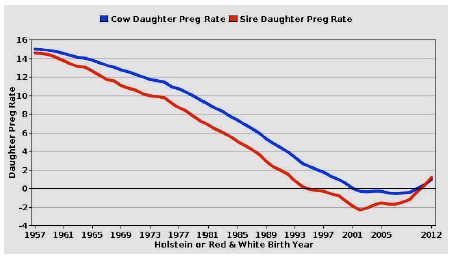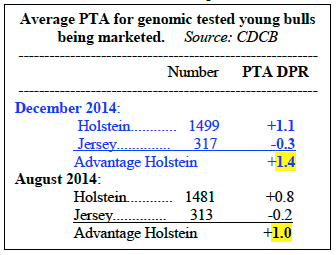
With the December 2014 national dairy genetic evaluations, USDA and the Council on Dairy Cattle Breeding (CDCB) introduced a new method of measuring Daughter Pregnancy Rate (DPR), along with other model enhancements. The old definition of DPR was number of Days Open, which was then converted to a pregnancy rate within a 21-day cycle. Days open was measured from the end of the voluntary waiting period to either a confirmed pregnancy or 250 days-in-milk. The new definition is an actual observation of pregnancy; a series of "no" or "yes" measures at 21-day intervals between 50 and 250 days in milk. Cows lacking pregnancy confirmation data at 250 days-in-milk are now assumed to be open.

The new DPR measurements are much more accurate. The genetic trend for all breeds is estimated to be twice as large as before. Improvements in fertility management from the early 1960s until the year 2000 was not sufficient to keep up with the decline in genetic merit. From 2000 on, Holstein breeders have emphasized fertility in their breeding selections. That not only halted the long term decline, but the Holstein is the only breed to see a significant upturn in the DPR values. Source:https://www.cdcb.us/eval/summary/trend.cfm?R_Menu=HO.d#StartBody

The new DPR information utilizes the actual breeding info and conception rates more fully to determine the 21-day pregnancy rate. The change in definition of DPR has had an impact on not only the DPR values but also on several other traits and subsequently on our estimate of breed differences and the ranking of top animals. The new DPR values show a greater increase for the top Holstein genomic young bulls compared to their contemporaries from the Jersey breed.
The improved fertility and Productive Life (PL) evaluations now have a stronger relationship with an animal's TPI® value. The new DPR value handles differences in voluntary waiting period much better. There's less emphasis on early conception and more on conception rates throughout the lactation. Bulls whose daughters had a longer voluntary waiting period have seen an improvement in their DPR proof. For example, the DPR values on high type bulls like Atwood and Gold Chip have gone up. The first breeding of the daughters of these bulls would have been delayed to obtain a 365-day record. The DPR values of high-index bulls like Robust, Numero Uno, and Shamrock have also gone up. Some of their daughters were being flushed and would have had a longer voluntary waiting period.

All of this has led to a higher correlation with the TPI® values. The new DPR values are more highly correlated with Heifer Conception Rate (HCR), Cow Conception Rate (CCR), and Productive Life. We even see a slight increase with production, giving us an overall increase correlation between the new DPR values with TPI®.
Many breeders were surprised to see the higher relationship among the top TPI® animals and their corresponding high fertility values. Part of the explanation of this change is an increase in the spread, or range (Standard Deviations), of the PTAs for all of the fertility traits, as well as Productive Life. Adjusting the Standard Deviations of the traits used in the TPI® formula will move some emphasis from the fertility traits over to the production traits. This comes closer to the original TPI® formula changes announced this summer.
The Genetic Advancement Committee of the Holstein Association USA, Inc. (HAUSA), met on December 17 to discuss the December genetic evaluation changes and recommended an adjustment to the Standard Deviations used in the TPI® formula. The implementation plan, approved by the HAUSA board of directors on December 18, is:
Implementation Plan:
- The current December 2014 TPI® values will remain official until the next full genetic evaluation update in April 2015.
- New Standard Deviations will be used in April 2015 to account for the increased spread created by the new DPR definition.
- The updated values of 2187 and 3.9 in the TPI® formula are being used to maintain the same genetic base and range as the current December 2014 TPI® values.
The complete TPI® formula with updated Standard Deviations, starting in April 2015, is as follows:

Adjusting the TPI® formula for the new Standard Deviations will only have a small impact on TPI values and the ranking of top animals. For example, for the top 100 Genomic bulls, the average change is 1 TPI point when comparing the current TPI® values with the TPI® value using the new Standard Deviations. The average change up or down is 11 TPI points, so there is a little reshuffling or reranking. However, we will not alter the status of any of the top bulls or top cows; they are still top animals.
Announcing the April 2015 TPI® formula now will help breeders to better plan their future purchasing, breeding, and mating decisions.
12.23.2014